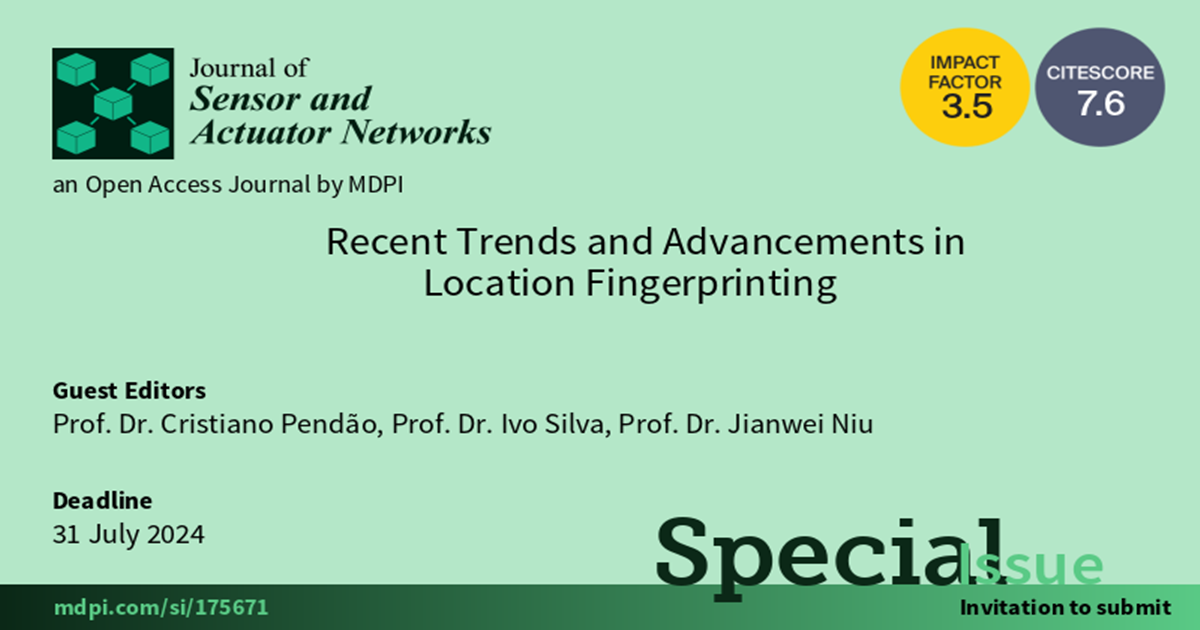Recent Trends and Advancements in Location Fingerprinting
A special issue of Journal of Sensor and Actuator Networks (ISSN 2224-2708). This special issue belongs to the section "Wireless Control Networks".
Deadline for manuscript submissions: 31 July 2024 | Viewed by 188

Special Issue Editors
Interests: mobile computing; positioning and navigation; computer vision/perception and machine learning
Interests: indoor positioning; indoor navigation; Industry 4.0; vehicle localization; mobile computing; computer networks; smart devices
Interests: big data analysis and computer vision techniques; big data analysis and natural language processing technology; intelligent robot operating system
Special Issue Information
Dear Colleagues,
Indoor positioning is crucial for supporting various types of applications, ranging from pedestrian localization and navigation to applications within the context of Industry 4.0 and the Internet of Things (IoT).
Fingerprinting is a popular technique utilized for indoor positioning, and can utilize various technologies and signals, including Wi-Fi, Bluetooth Low Energy (BLE), or the magnetic field. One of the key reasons for the popularity of fingerprinting is its versatility in different environments. Additionally, it enables the estimation of positions in indoor spaces without the need for access point positions, floor plan information, or the deployment of dedicated infrastructure or specialized hardware.
Challenges associated with RSS-based fingerprinting are usually related to the calibration phase, with the creation and maintenance of the radio map, which may be manual or automated. The quality of the radio map influences the online phase when a position estimate is obtained by comparing a new fingerprint with a radio map. Different approaches have been proposed for the matching process, leading to different levels of performance. Furthermore, fingerprinting is often combined with other positioning techniques (e.g., dead reckoning) and sensors (e.g., IMUs, odometers, cameras, etc.) to enhance the overall positioning performance.
Despite its popularity, further research is needed to explore both novel and established technologies, techniques, and methods in location fingerprinting. Additionally, there is a need to develop fair benchmarking methods to evaluate real-world performance and assess the deployment complexity across diverse scenarios and applications.
Topics of interest include, but are not limited to:
- Novel fingerprinting positioning solutions;
- Emerging technologies for positioning (e.g., 5G, Wi-Fi 6, etc.);
- Enhancing location fingerprinting with data fusion;
- Hybrid indoor positioning systems;
- New methods for radio map creation and maintenance;
- Crowdsourcing approaches in location fingerprinting;
- Data collection and management for large-scale location fingerprint databases;
- Generative modelling in indoor positioning;
- Datasets for positioning;
- Evaluation and benchmarking of location fingerprinting methods and systems;
- Comparative studies including location fingerprinting;
- Enhancing location fingerprinting with artificial intelligence;
- Privacy-preserving techniques for location fingerprinting in iot and smart environments;
- Applications of location fingerprinting in smart buildings, healthcare, and retail.
Prof. Dr. Cristiano Pendão
Prof. Dr. Ivo Silva
Prof. Dr. Jianwei Niu
Guest Editors
Manuscript Submission Information
Manuscripts should be submitted online at www.mdpi.com by registering and logging in to this website. Once you are registered, click here to go to the submission form. Manuscripts can be submitted until the deadline. All submissions that pass pre-check are peer-reviewed. Accepted papers will be published continuously in the journal (as soon as accepted) and will be listed together on the special issue website. Research articles, review articles as well as short communications are invited. For planned papers, a title and short abstract (about 100 words) can be sent to the Editorial Office for announcement on this website.
Submitted manuscripts should not have been published previously, nor be under consideration for publication elsewhere (except conference proceedings papers). All manuscripts are thoroughly refereed through a single-blind peer-review process. A guide for authors and other relevant information for submission of manuscripts is available on the Instructions for Authors page. Journal of Sensor and Actuator Networks is an international peer-reviewed open access semimonthly journal published by MDPI.
Please visit the Instructions for Authors page before submitting a manuscript. The Article Processing Charge (APC) for publication in this open access journal is 2000 CHF (Swiss Francs). Submitted papers should be well formatted and use good English. Authors may use MDPI's English editing service prior to publication or during author revisions.
Keywords
- indoor positioning
- indoor localization
- fingerprinting
- Wi-Fi
- BLE
- radio maps
- collaborative indoor positioning







